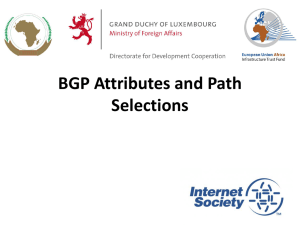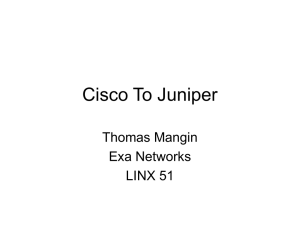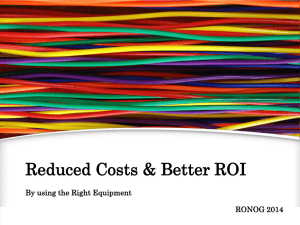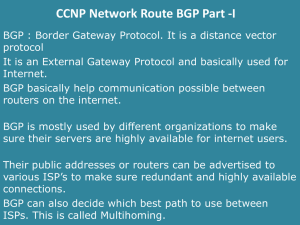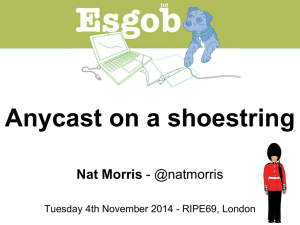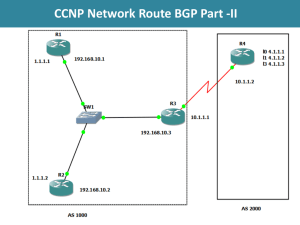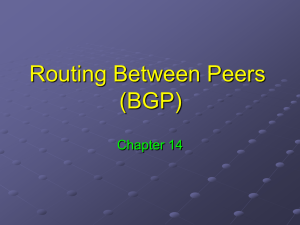BGP Intro - African Union Pages
advertisement
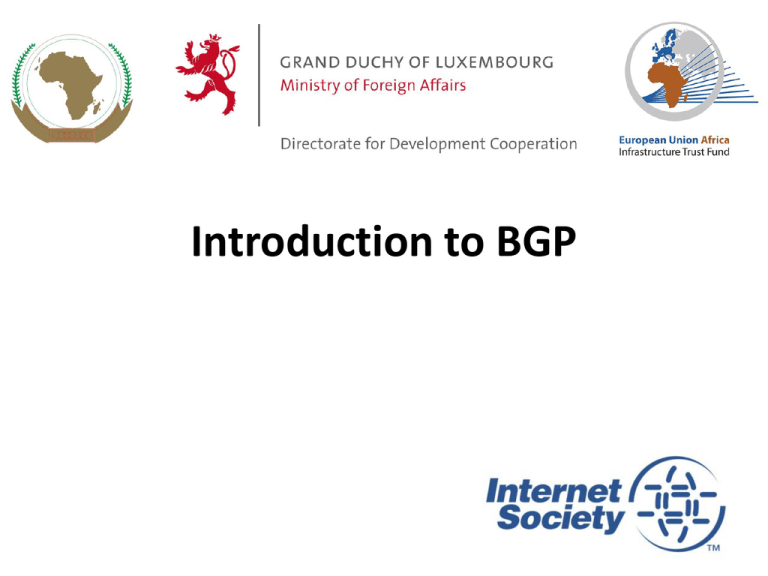
Introduction to BGP 1 Border Gateway Protocol • A Routing Protocol used to exchange routing information between different networks – Exterior gateway protocol • Described in RFC4271 – RFC4276 gives an implementation report on BGP – RFC4277 describes operational experiences using BGP • The Autonomous System is the cornerstone of BGP – It is used to uniquely identify networks with a common routing policy 2 BGP • • • • • • Path Vector Protocol Incremental Updates Many options for policy enforcement Classless Inter Domain Routing (CIDR) Widely used for Internet backbone Autonomous systems 3 Path Vector Protocol • BGP is classified as a path vector routing protocol (see RFC 1322) – A path vector protocol defines a route as a pairing between a destination and the attributes of the path to that destination. 12.6.126.0/24 207.126.96.43 1021 0 6461 7018 6337 11268 i AS Path 4 Path Vector Protocol AS6337 AS11268 AS7018 AS500 AS6461 AS600 5 Definitions • Transit – carrying traffic across a network, usually for a fee • Peering – exchanging routing information and traffic • Default – where to send traffic when there is no explicit match in the routing table 6 Default Free Zone The default free zone is made up of Internet routers which have explicit routing information about the rest of the Internet, and therefore do not need to use a default route NB: is not related to where an ISP is in the hierarchy 7 Peering and Transit example provider A IXP-West Backbone Provider D IXP-East provider B provider C • A and B can peer, but need transit arrangements with D to get packets to/from C 8 Autonomous System (AS) AS 100 • Collection of networks with same routing policy • Single routing protocol • Usually under single ownership, trust and administrative control • Identified by a unique 32-bit integer (ASN) 9 Autonomous System Number (ASN) • Two ranges – 0-65535 (original 16-bit range) – 65536-4294967295 (32-bit range – RFC4893) • Usage: – – – – – 0 and 65535 (reserved) 1-64495 (public Internet) 64496-64511 (documentation – RFC5398) 64512-65534 (private use only) 23456 (represent 32-bit range in 16-bit world) – 65536-65551 (documentation – RFC5398) – 65552-4294967295 (public Internet) • 32-bit range representation specified in RFC5396 – Defines “asplain” (traditional format) as standard notation 10 Autonomous System Number (ASN) • ASNs are distributed by the Regional Internet Registries – They are also available from upstream ISPs who are members of one of the RIRs • Current 16-bit ASN allocations up to 61439 have been made to the RIRs – Around 41200 are visible on the Internet • Each RIR has also received a block of 32-bit ASNs – Out of 2800 assignments, around 2400 are visible on the Internet • See www.iana.org/assignments/as-numbers 11 Configuring BGP in Cisco IOS • This command enables BGP in Cisco IOS: router bgp 100 • For ASNs > 65535, the AS number can be entered in either plain or dot notation: router bgp 131076 or router bgp 2.4 • IOS will display ASNs in plain notation by default – Dot notation is optional: router bgp 2.4 bgp asnotation dot 12 BGP Basics Peering A C AS 100 AS 101 D B • • • • Runs over TCP – port 179 Path vector protocol Incremental updates “Internal” & “External” BGP E AS 102 13 Demarcation Zone (DMZ) A AS 100 DMZ Network B C AS 101 D E AS 102 • DMZ is the link or network shared between ASes 14 BGP General Operation • Learns multiple paths via internal and external BGP speakers • Picks the best path and installs it in the routing table (RIB) • Best path is sent to external BGP neighbours • Policies are applied by influencing the best path selection 15 Constructing the Forwarding Table • BGP “in” process – receives path information from peers – results of BGP path selection placed in the BGP table – “best path” flagged • BGP “out” process – announces “best path” information to peers • Best path stored in Routing Table (RIB) • Best paths in the RIB are installed in forwarding table (FIB) if: – prefix and prefix length are unique – lowest “protocol distance” 16 Constructing the Forwarding Table BGP in process in discarded accepted everything bgp BGP table peer routing table best paths out BGP out process forwarding table 17 eBGP & iBGP • BGP used internally (iBGP) and externally (eBGP) • iBGP used to carry – Some/all Internet prefixes across ISP backbone – ISP’s customer prefixes • eBGP used to – Exchange prefixes with other ASes – Implement routing policy 18 BGP/IGP model used in ISP networks • Model representation eBGP eBGP eBGP iBGP iBGP iBGP iBGP IGP IGP IGP IGP AS1 AS2 AS3 AS4 19 External BGP Peering (eBGP) A AS 100 C AS 101 B • Between BGP speakers in different AS • Should be directly connected • Never run an IGP between eBGP peers 20 Configuring External BGP ip address on ethernet interface Router A in AS100 interface ethernet 5/0 ip address 102.102.10.2 255.255.255.240 ! Local ASN router bgp 100 network 100.100.8.0 mask 255.255.252.0 Remote ASN neighbor 102.102.10.1 remote-as 101 neighbor 102.102.10.1 prefix-list RouterC in neighbor 102.102.10.1 prefix-list RouterC out ! ip address of Router C ethernet interface Inbound and outbound filters 21 Configuring External BGP ip address on ethernet interface Router C in AS101 interface ethernet 1/0/0 ip address 102.102.10.1 255.255.255.240 ! Local ASN router bgp 101 network 100.100.64.0 mask 255.255.248.0 Remote ASN neighbor 102.102.10.2 remote-as 100 neighbor 102.102.10.2 prefix-list RouterA in neighbor 102.102.10.2 prefix-list RouterA out ! ip address of Router A ethernet interface Inbound and outbound filters 22 Internal BGP (iBGP) • BGP peer within the same AS • Not required to be directly connected – IGP takes care of inter-BGP speaker connectivity • iBGP speakers must be fully meshed: – They originate connected networks – They pass on prefixes learned from outside the ASN – They do not pass on prefixes learned from other iBGP speakers 23 Internal BGP Peering (iBGP) AS 100 A B C D • Topology independent • Each iBGP speaker must peer with every other iBGP speaker in the AS 24 Peering between Loopback Interfaces AS 100 C A B • Peer with loop-back interface – Loop-back interface does not go down – ever! • Do not want iBGP session to depend on state of a single interface or the physical topology 25 Configuring Internal BGP ip address on loopback interface Router A in AS100 interface loopback 0 ip address 105.3.7.1 255.255.255.255 ! Local ASN router bgp 100 network 100.100.1.0 Local ASN neighbor 105.3.7.2 remote-as 100 neighbor 105.3.7.2 update-source loopback0 neighbor 105.3.7.3 remote-as 100 neighbor 105.3.7.3 update-source loopback0 ! ip address of Router B loopback interface 26 Configuring Internal BGP ip address on loopback interface Router B in AS100 interface loopback 0 ip address 105.3.7.2 255.255.255.255 ! Local ASN router bgp 100 network 100.100.1.0 Local ASN neighbor 105.3.7.1 remote-as 100 neighbor 105.3.7.1 update-source loopback0 neighbor 105.3.7.3 remote-as 100 neighbor 105.3.7.3 update-source loopback0 ! ip address of Router A loopback interface 27 Inserting prefixes into BGP • Two ways to insert prefixes into BGP – redistribute static – network command 28 Inserting prefixes into BGP – redistribute static • Configuration Example: router bgp 100 redistribute static ip route 102.10.32.0 255.255.254.0 serial0 • Static route must exist before redistribute command will work • Forces origin to be “incomplete” • Care required! 29 Inserting prefixes into BGP – redistribute static • Care required with redistribute! – redistribute <routing-protocol> means everything in the <routing-protocol> will be transferred into the current routing protocol – Will not scale if uncontrolled – Best avoided if at all possible – redistribute normally used with “routemaps” and under tight administrative control 30 Inserting prefixes into BGP – network command • Configuration Example router bgp 100 network 102.10.32.0 mask 255.255.254.0 ip route 102.10.32.0 255.255.254.0 serial0 • A matching route must exist in the routing table before the network is announced • Forces origin to be “IGP” 31 Configuring Aggregation • Three ways to configure route aggregation – redistribute static – aggregate-address – network command 32 Configuring Aggregation • Configuration Example: router bgp 100 redistribute static ip route 102.10.0.0 255.255.0.0 null0 250 • static route to “null0” is called a pull up route – packets only sent here if there is no more specific match in the routing table – distance of 250 ensures this is last resort static – care required – see previously! 33 Configuring Aggregation – Network Command • Configuration Example router bgp 100 network 102.10.0.0 mask 255.255.0.0 ip route 102.10.0.0 255.255.0.0 null0 250 • A matching route must exist in the routing table before the network is announced • Easiest and best way of generating an aggregate 34 Configuring Aggregation – aggregate-address command • Configuration Example: router bgp 100 network 102.10.32.0 mask 255.255.252.0 aggregate-address 102.10.0.0 255.255.0.0 [summary-only] • Requires more specific prefix in BGP table before aggregate is announced • summary-only keyword – Optional keyword which ensures that only the summary is announced if a more specific prefix exists in the routing table Summary BGP neighbour status Router6>sh ip bgp sum BGP router identifier 10.0.15.246, local AS number 10 BGP table version is 16, main routing table version 16 7 network entries using 819 bytes of memory 14 path entries using 728 bytes of memory 2/1 BGP path/bestpath attribute entries using 248 bytes of memory 0 BGP route-map cache entries using 0 bytes of memory 0 BGP filter-list cache entries using 0 bytes of memory BGP using 1795 total bytes of memory BGP activity 7/0 prefixes, 14/0 paths, scan interval 60 secs Neighbor 10.0.15.241 10.0.15.242 10.0.15.243 ... V 4 4 4 AS MsgRcvd MsgSent 10 9 8 10 6 5 10 9 8 BGP Version TblVer 16 16 16 InQ OutQ Up/Down State/PfxRcd 0 0 00:04:47 2 0 0 00:01:43 2 0 0 00:04:49 2 Updates sent Updates waiting and received 36 Summary BGP Table Router6>sh ip bgp BGP table version is 30, local router ID is 10.0.15.246 Status codes: s suppressed, d damped, h history, * valid, > best, i internal, r RIB-failure, S Stale Origin codes: i - IGP, e - EGP, ? - incomplete Network *>i10.0.0.0/26 *>i10.0.0.64/26 *>i10.0.0.128/26 *>i10.0.0.192/26 *>i10.0.1.0/26 *> 10.0.1.64/26 *>i10.0.1.128/26 *>i10.0.1.192/26 ... Next Hop 10.0.15.241 10.0.15.242 10.0.15.243 10.0.15.244 10.0.15.245 0.0.0.0 10.0.15.247 10.0.15.248 Metric LocPrf Weight Path 0 100 0 i 0 100 0 i 0 100 0 i 0 100 0 i 0 100 0 i 0 32768 i 0 100 0 i 0 100 0 i 37 Summary • • • • BGP4 – path vector protocol iBGP versus eBGP stable iBGP – peer with loopbacks announcing prefixes & aggregates 38 Acknowledgement and Attribution This presentation contains content and information originally developed and maintained by the following organisation(s)/individual(s) and provided for the African Union AXIS Project Cisco ISP/IXP Workshops Philip Smith: - pfsinoz@gmail.com www.apnic.net Introduction to BGP End 40

